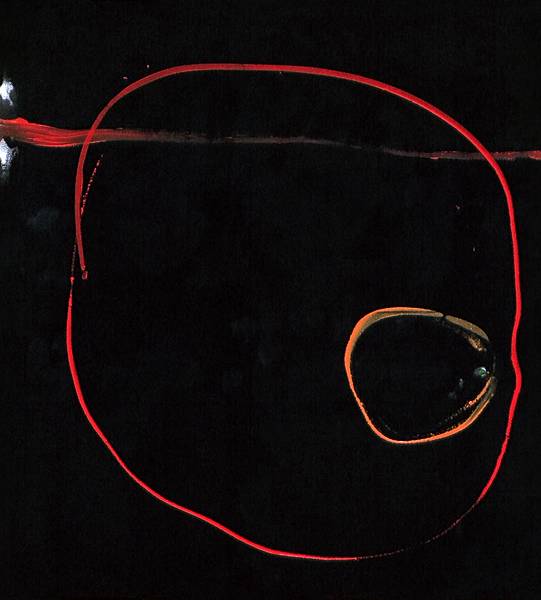2001 - 35

●
剎那 剎那
火紅的剎那 之一
壓克力 畫布
100 + 100 cm . 47
2001
義大利 Piazza Delle Erbe Private Art Gallery 收藏

●
剎那 剎那
火紅的剎那 之二
壓克力 畫布
90 + 100 cm . 43
2001
義大利 Piazza Delle Erbe Private Art Gallery 收藏
東 方 的 心 靈 哲 學
吳銀海在這些青年藝術家之中,年紀是最輕的,然而他對於心性的圓熟
,卻是最老成的:「要達到近處,你必須旅行到遠處,那個已經被達成
的,你必須再去達成。」他堅持「清明」的純粹,一個心無雜念的冥想
、寧靜狀態。而在技巧上,他致力於將行動與內在狀態合而為一的書寫
。書寫的抽象體系、動勢與線條的表現,與抽象繪畫的基本元素不謀而
合。而吳銀海將書法藝術對於氣、念、空間與行動合一的觀念,運用在
繪畫創作上,就如同他自己所企圖獲致的:「一個決定性的書寫」、「
一個決定性的色面」。
文 / 潘娉玉 / 2003.1200
出處 / 台灣當代美術大系 媒材篇─油彩與壓克力
行政院文化建設委員會出版
Surface is depth, not
expanse/giulio angelucci
In the banality of a happy ending, one of the duelists yields and the victor, in losing hid adversary, kills his “Own” antagonist embodied in the figure of the person against whom he was fighting. On consideration, now that the great cloud of dust caused by the fall of the Wall is dissipating and every echo of the clamour engendered by the fall has quietened down, the disappearance of the shadow antagonist of our Western civilization re-evokes Mao Tse Tung’s aphorism on the two halves of the sky. Along with the Iron Curtain, the possibility suggested by the demarcation line marking a place which was beyond what is our “Own” also vanished:
But the sky is depth, not expanse.
The deep sky of certain obsessively fine days (full of a clear and intense luminosity, outside any seasonal definition) could be described as “enameled”. The adjective refers to certain old goldsmiths’ enamels, obtained with the inclusion of opaque material whose glazing -rather than volatility – confers mineral compactness, hardness and thickness. But the resulting abyss of light and colour is not within the fused substance, it is as if it were extracted and concentrated in the infinitesimal thickness of the reflective quality of the surface. In the same way in which the shining light of Stanley Kubrik’s film The Shining allows the main character – fully and deeply – to move blindly through the snow-covered labyrinth, his pursuit of the dark is illuminated by surface gleams which are instantaneous and crystalline.
What else can be said of the imagined idea that is being propose here, which resides and breathes in a space with no thickness or content, with no thought or psychological sense? The soul of the West consisting of the superimposition of “feeling” romantic over “seeing” in perspective, finds inconceivable the idea of a sensibility that has historically been WITHOUT these things. But in accepting this idea of the East as the vertigo of the unthinkable (without cautiously turning one’s eyes away and without giving in to the seductive headiness of holiday exoticism) one discovers in it an unexpected workability.
In the world which has been globally reduced to its own half, where walls no longer separate from anything and where no distance exists between us and the impossible, the “beyond what is our own” seems to make a return in the possibility of a future natural condition, to be won back beyond the hopeless demise of the original inheritance which was founded by the explorability of the world.
Having lost the original Principle(the created world), the anxious vagueness of an infinite recreation establishes the only possibility (and therefore the absolute necessity) to constitute countries and worlds upon the necessity of the impossible.
Countries and worlds to create, not to explore. Thus they are places of projection, unconditioned screens, mirrors which exclude all presupposition.
And they air also enameled surfaces: intense, deep, indifferent to all definition.
I believe that the main reason for interest in this exhibition lies in the particular circumstances surrounding the training of Wu Ying-Hai and Chen Wen-Chih, both Taiwan Chinese, both little more than twenty years old.
Descending from the teachings of Hsiao Chin and from the cultural meditation in which he evolved, their work creates a compatibility between western aesthetics and the perspective of the oriental imagination. For this precise reason it provides exceptional access to that WIYHOUT of psychology and space that would normally be inaccessible to us.
It is therefore possible that, notwithstanding the philosophical and religious motivations that Wu Ying-Hai allows in his work (and beyond the aestheticawareness which feeds it), his painting offers a germinal and assertive quality, a full plausibility of the the world creates it. This is an ethical factor which corresponds to the fact that this quality dwells entirely within the format, the material and the system of the painting. What this quality determines and prepares excludes – at least to our eyes – every metaphorical and gestural insinuation, every possible reference to a content and to an existence which is outside the image and which precedes the painting.
Younger also in chronological terms, Chen Wen-Chih, for his part, proposes explosive images of scintillating and playful mobility. His luciferian kaleidoscope promises an endless performance of shapes, colours and stories. It produces a joyful intrusiveness (it has been called “A Utopia of the heart”) that makes the painting ingo the myth of variety, of challenge, of lightness, of seduction, of mirth and of wonder. It is able to float zestfully upon darkness, to slide vivaciously into the heart of conflict and to emerge sensullly from anguish. It manifests itself. It is tragic and optimistic, like the tireless eternity of play.
As Wu Ying-Hai proposes ‘concave’ painting, so Wen-Chih offers ‘convex’ painting.
The figure of the lens, which is the result of these two opposite types of surface is the introductory metaphor of the exhibition. Look at the painting. Not in order to reform the world, but to recreate the imagination.
(translated by paul bowley)
願 ………
這 些作品能利益對藝術有興趣的人
並 祝福一切有情
精 力更為充沛
在 靈性上
快 樂的相遇
…………………………………………………………………………………
以上作品,皆有著作權法之保護。如未經同意,請勿任意作為
商業利益之使用。
Above all works,involves question of the work
copyright,without the permission,please do not take use
of the commercial interest.


 留言列表
留言列表